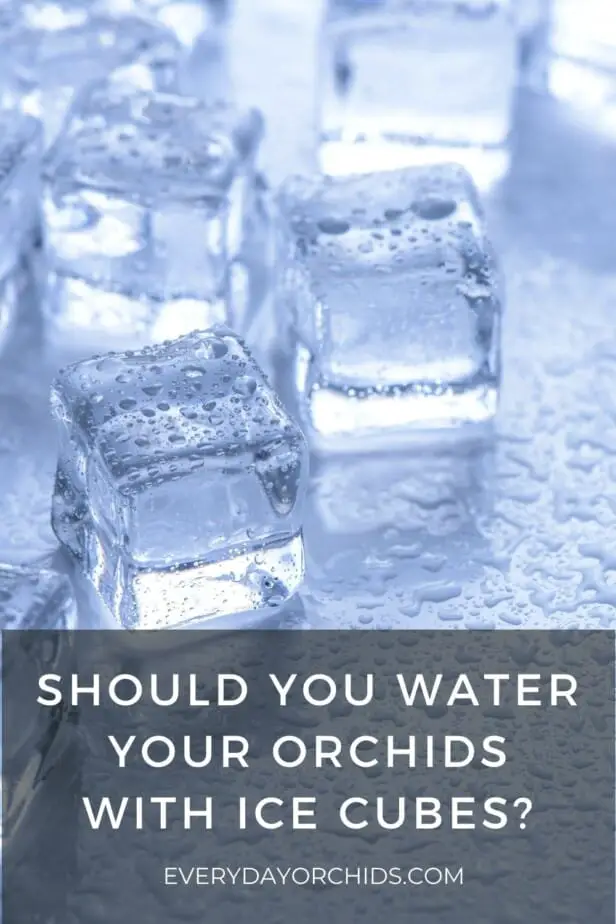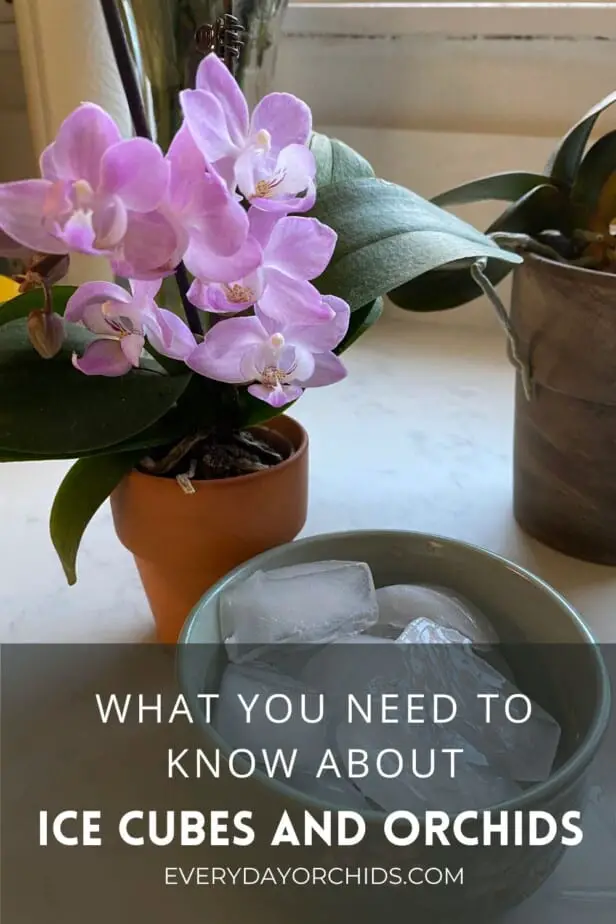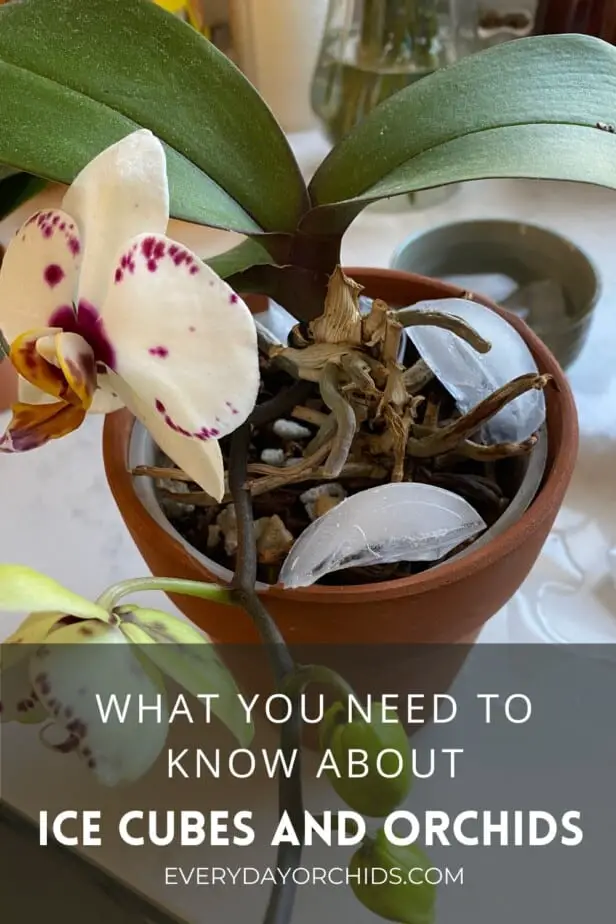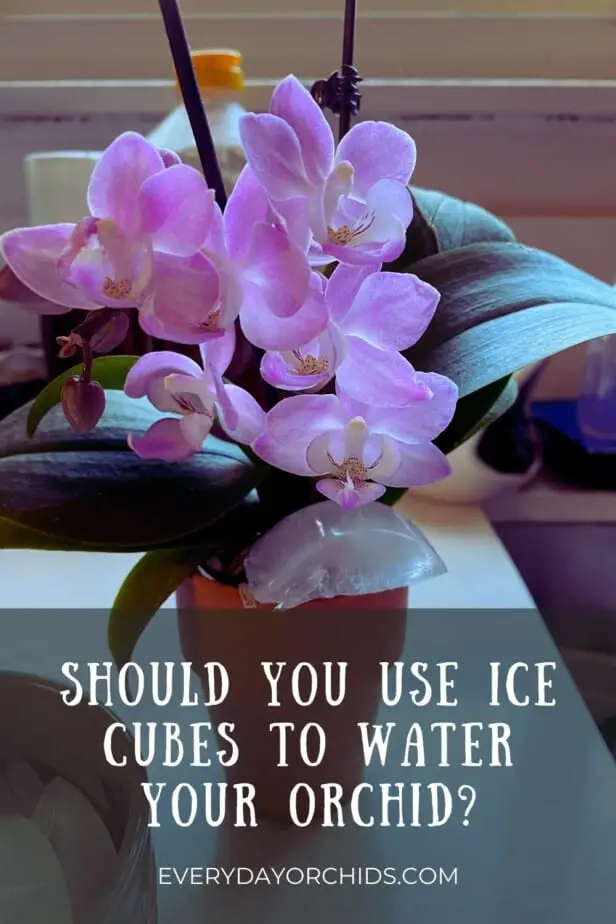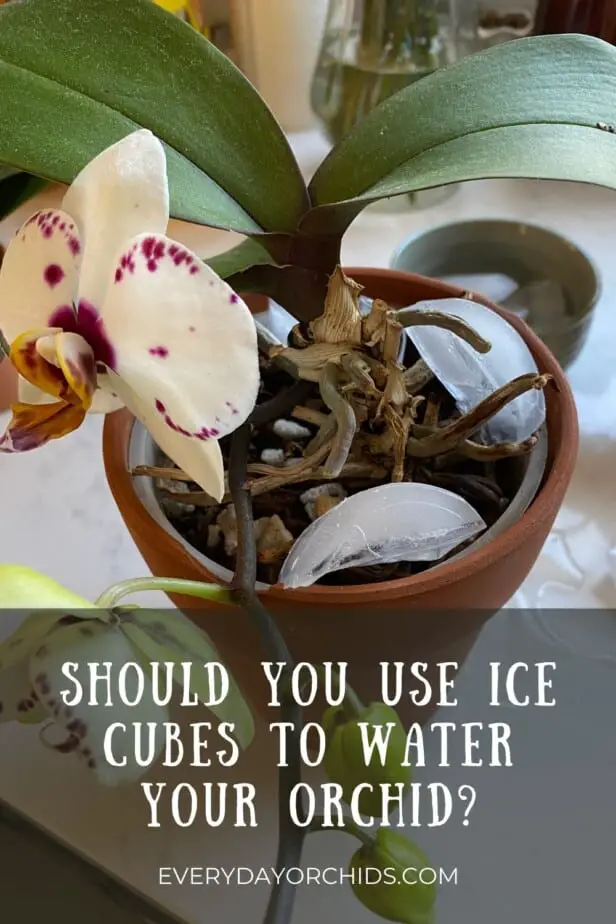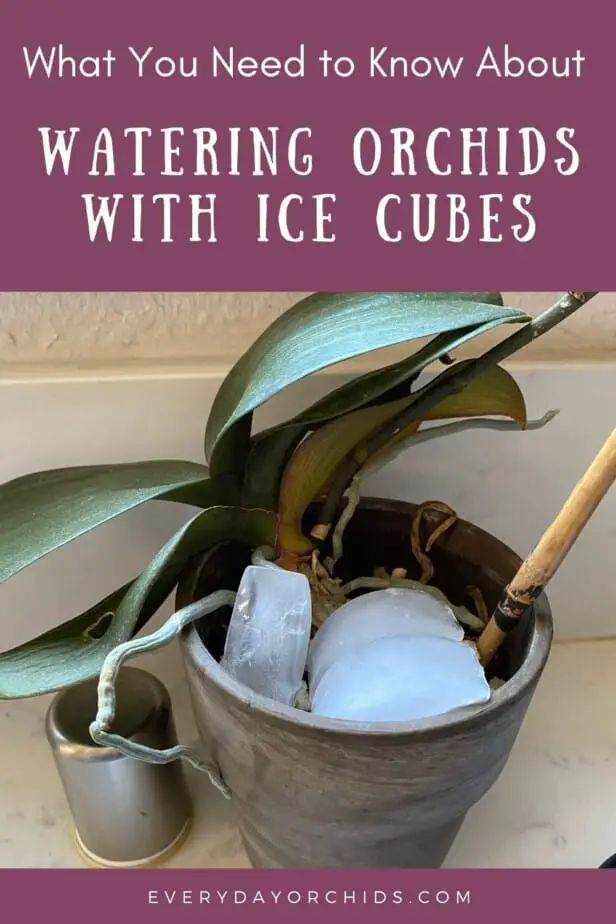Watering orchids with ice cubes is a controversial topic among orchid growers. There are some who believe watering orchids with ice cubes is the way to go.
Some people swear by it, claiming it is the simplest and easiest method for watering orchids. Other orchid growers discourage using ice cubes, citing the detrimental effects ice can have on orchids and orchid roots.
So what is right? Should you water your orchids with ice cubes?
To water your orchids using ice cubes, you would use three ice cubes per plant, once a week. The benefits to using this method is that it prevents overwatering and simplifies the watering routine for busy people. There are a number of drawbacks to using ice cubes however. Among other problems, using ice cubes to water orchids can lead to leaf damage, crown rot, or root damage over time.
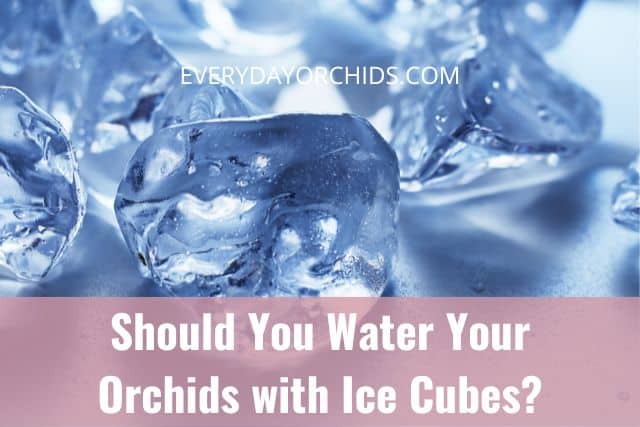
In this article, I will look at the pros and cons of using ice cubes to water orchid plants. Based on this information, you can make a decision whether or not using ice cubes to water your orchids is right for you.
Please note that these links are affiliate links and as an Amazon Associate, I earn from qualifying purchases. Purchases made through affiliate links in this post may generate commissions at no additional cost to you. Use this link for a discounted Amazon Prime trial. Thank you for your support!
Table of Contents
How To Water Orchids With Ice Cubes
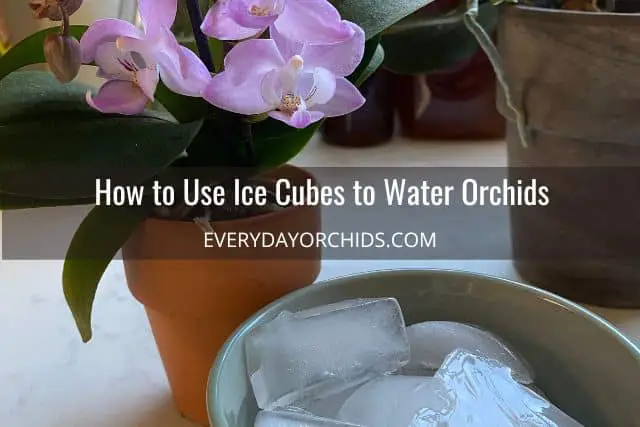
Perhaps watering orchids with ice cubes is a new concept that you haven’t heard of before, and you are wondering how exactly to do it.
To use the ice cube method to water your orchids, take three ice cubes and place them on top of the potting media. Avoid placing the ice cubes on the leaves or directly on the roots. Space the ice cubes evenly apart in the pot so the water distribution is even. Do this once a week to water your orchids.
If you have a larger orchid or a larger pot, you may need to use more than three ice cubes. Use your own judgement. You can start with four ice cubes and increase the amount as needed. If you have a mini Phalaenopsis orchid, you may only need one or two ice cubes.
Is It Safe To Water Orchids With Ice Cubes?
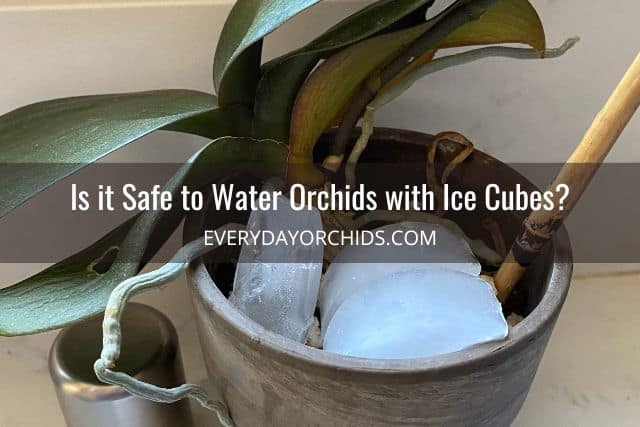
As I mentioned above, the majority of orchids grow in tropical climates. The water they receive is warm, or at least, room-temperature rain water. They are not accustomed to cold water, much less ice water.
Essentially, when you use ice cubes to water your orchids, you are shocking the plant with freezing temperatures.
Orchid growers who are against using the ice cube method really emphasize this point. There is some concern that using ice cubes to water orchids will cause damage to the orchid and orchid roots.
Interestingly, a research study was done to find out whether or not it is safe to water orchids with ice cubes. This study was published in HortScience.
In the study, researchers watered Phalaenopsis orchids with ice cubes versus room-temperature water. They used three ice cubes per orchid plant and the equivalent amount of room-temperature water for the control plants.
They observed the orchids for four to six months. During this time, researchers monitored the flower life, root and leaf health, and temperatures of the potting media and orchid roots.
Researchers found that the quality and longevity of the orchid blooms was unaffected by watering with ice cubes. When the ice cubes were applied, the temperature of the bark potting media went down to 11 degrees Celsius (about 51 degrees Fahrenheit).
However, damage to the orchid roots’ photosystem did not occur until -7 degrees Celsius (about 19 degrees Fahrenheit). Even when ice cubes had direct contact with the orchid roots, the researchers found that the lowest internal temperature of the roots was 4 degrees Celsius (about 39 degrees Fahrenheit).
At the conclusion of the study, the researchers found that using ice cubes to water orchids did not harm the orchid plants or roots. According to this study, using ice cubes as a watering method is a safe and effective way to water orchid plants.
Study Limitations
It is important to note that this study only covered four to six months. That is a major limitation of this study. What happened to the orchids afterwards? Did they continue to live, or even thrive, the following year when compared to other orchids watered with room-temperature water?
Orchids, if cared for properly, can live years, possibly decades. The long-term effects of using ice cubes to water orchids have not been studied. Take this into consideration before opting to use this method on your own orchid plants.
Benefits of Using Ice Cubes To Water Orchids

A couple of my friends use the ice cube method to water their orchids and they love it. Their main reasons are that using ice cubes is so easy and prevents overwatering.
Maybe you know of some people who use ice cubes to water their plants as well. You may be wondering why people would choose to use ice cubes to water orchids and what the benefits may be.
Avoids Overwatering
One major benefit to using ice cubes to water your orchids is that you avoid overwatering your plant. Using three ice cubes per plant limits you to using a finite amount of water each week. When melted down, three ice cubes equals approximately one-quarter cup of water.
Of course, different sized ice cubes will yield varying amounts of water. I melted down three ice cubes made by my freezer’s ice dispenser and it was just under a quarter cup of water.
If I were to use three ice cubes from a standard-sized ice cube tray, I would imagine I would get around one-third cup of water, since those ice cubes are bigger.
The exact amount of water may vary, but the point is that by using only three ice cubes each week to water your orchid, you are limiting the amount of water your orchid receives. By doing so, you are avoiding overwatering your plant and therefore, can reduce the chances for root rot.
Keep in mind that you will still need to check your orchid’s potting media before you water with ice cubes. Stick your finger in the top two inches of potting media and check for dampness.
If the potting media is still damp from the previous week’s watering, then you will want to wait a few days before watering your orchid. If the potting media is dry, however, go ahead and water your orchid with ice cubes.
Simplifies the Watering Routine
Using ice cubes to water orchids really simplifies watering. Even ice cube method haters won’t deny how easy this method is. You just go to your freezer, grab three ice cubes per orchid, place them in the orchid pot, and you’re done with watering for the week. That took, what, two minutes?
For busy orchid growers, or people who have dozens of orchids, using ice cubes to water orchids really streamlines the watering process. Instead of being a weekly chore of bringing orchids to the sink or placing orchid pots in basins of water, this is a quick and easy way of watering your plants.
Provides Orchids with a Slow Steady Amount of Water
Unlike with other watering methods, where you might pour water into the orchid pot, or soak the orchid pot in a basin of water, ice cubes provide a slow trickle of water to your orchids. This gives the orchid roots time to absorb the water. The slow melting of the ice provides the orchid plant a small, steady supply of water over the course of several hours.
Drawbacks of Using Ice Cubes to Water Orchids
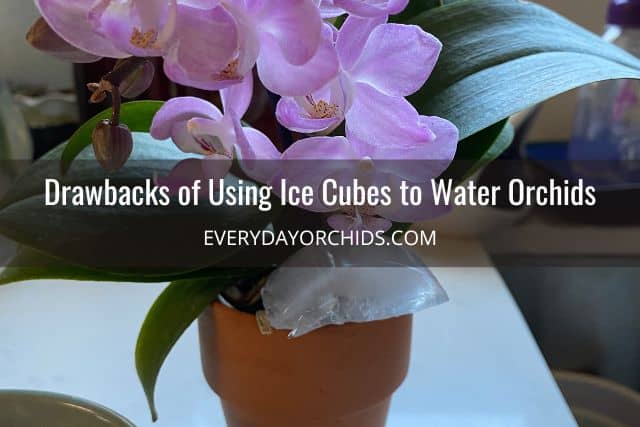
I know the first time I heard of using the ice cube method to water orchids, I just couldn’t wrap my head around it. I normally use the soaking method to water my orchids. This involves placing my orchid pots in a basin of room-temperature water for about five to ten minutes, once every 7 to 10 days. For me, this method has worked well for years.
Then, one day, my coworkers were talking about using ice cubes to water their orchids. I had a lot of questions. Wouldn’t using ice cubes damage the orchid roots? Isn’t it too cold? Orchids are tropical plants. How would they handle the extreme cold of ice water on their roots?
There are some major drawbacks of using ice cubes to water orchids, and I will talk about those next.
Cold Temperatures Will Add Stress to the Orchid
Orchids are tropical plants. There is never a time in the rainforest when orchids are exposed to ice water. Instead the water they encounter is warm, tropical water.
If you have been watering your orchid with room-temperature water, then suddenly switch to using ice cubes, there is a high chance you will shock and cause stress to your orchid plant.
Anytime an orchid’s environment has a change, whether it is due to repotting, trimming of roots, or watering with ice cubes, it will cause stress to the orchid.
If your orchid is already having problems and is not healthy, there is a high chance it will start to slowly decline.
You may not notice this at first. The orchid may continue to grow and bloom for a while. It may even produce keiki plants.
However, remember that sometimes, an orchid produces keiki plants as a last ditch effort to pass on its genes. Likewise, it may flower, hoping to attract pollinators in a last ditch effort to be fertilized and pass on its genetic material.
Ice Puts the Orchid Outside Its Temperature Tolerance Levels
The study referenced above noted that adding ice to the orchid’s potting media brought the temperatures of the potting media bark down to about 11 degrees Celsius, or 51 degrees Fahrenheit. Most orchids do not have a temperature tolerance that goes down that low.
Exposing the orchid to temperatures below its tolerance level will cause unnecessary stress on the plant.
Watering your orchids with ice cubes once or twice may not cause long-term damage. However, week after week of using ice cubes to water your orchids can.
Orchid Roots May Not Receive Enough Water
Even though you are using three ice cubes per plant, per week, your orchid is probably not getting enough water.
As the ice cube melts, the water trickles down into the potting media. However, the water does not spread out into the entire pot. Rather, gravity makes the water go straight down and out.
If there are orchid roots in the potting media directly underneath that ice cube, they will get water. The other roots will not. In fact, the entire root is unlikely to get water. Just the areas of the root that are directly under the ice cube will receive water. This results in wet and dry areas on the same orchid root.
Even if you strategically place the ice around, three ice cubes are just not enough to moisten all of the potting media around your orchid’s roots. This will lead to uneven watering of your orchid plant.
Over time, your orchid will start to show signs of underwatering. Some orchid roots will appear dry and shriveled, while other roots, the roots that were in the melting ice cube’s pathway, look fine.
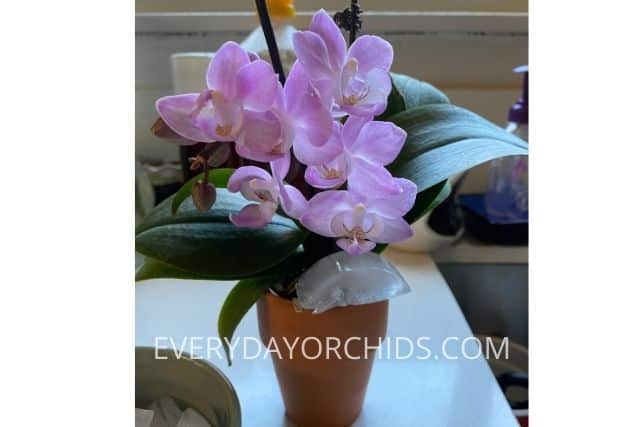
Case in point, see the picture above. That is my mini Phalaenopsis plant, with an ice cube for demonstration purposes. As you can see, the ice cube is too big for this little pot and the ice hangs over the edge. There’s no way that all the orchid roots will be evenly watered.
The ice cube also touches the orchid leaves and stem above. This is another big no-no, and I’ll talk about this more below. (I removed the ice cube after taking this picture, by the way.)
Risk for Damage to the Orchid Leaves
While it may seem fairly straightforward, watering orchids using the ice cube method has to be done in a certain way. You must place the ice cubes directly on top of the potting media. The ice should not touch the orchid leaves. Do not put any ice in the crown of the orchid plant.
Honestly, though, it is very hard to position the ice cubes in the orchid pot and not have any part of the ice cube touch any part of the orchid stem or leaf. This is especially true if you have a mini Phalaenopsis or a smaller orchid pot, where the orchid leaves hang down close to the potting media.
Prolonged contact of the orchid leaf to ice, or very cold temperatures, can cause cold injury and damage to the orchid leaf.
Cold damage can be seen as limp, or lifeless leaves, brown or black leaves, or brown or black pits in the leaves. In addition, the orchid leaf may be mildly squishy. This is due to the damage to the plant cells from the prolonged cold exposure. Similar damage will be seen on the orchid stem if that area is also has prolonged contact with ice cubes.
Risk for Crown Rot
Some orchid growers may casually toss ice cubes onto their orchid. If the ice cubes land in the crown of the orchid plant and start to melt, you have a high risk for crown rot happening.
In fact, this is highly likely because the ice cube method calls for you to add the ice cubes to your orchid pot and then walk away. As the ice melts and water pools in the orchid crown, rot can occur. If left untreated, crown rot can kill your orchid plant.
Difficult to Fertilize Your Orchid
How do you fertilize with the ice cube method? Unless you are planning to pre-make and dilute orchid fertilizer, and freeze it into ice cube trays, the answer is you cannot. (Taking the time to make orchid fertilizer ice cubes seems to defeat the purpose of making this process easy and quick, but I digress).
Most orchid fertilizers are sold in a concentrated form, requiring you to dilute the liquid or powder in water. Since orchids do not need heavy amounts of fertilizer, it is also generally recommended to further dilute your orchid fertilizer. This will enable you to prevent fertilizer burn on your orchid roots. If you want to learn more, please check out this resource about how to fertilize orchids.
If you are using the ice cube method each week for watering your orchid, it does not leave much room for fertilizing your orchid too. Orchid fertilizer is diluted with water. By fertilizing your orchid, you are also watering it at the same time. You might need to skip at least one week of using the ice cube method and instead fertilize your orchids with diluted orchid fertilizer water.
Final Thoughts
Watering your orchids is a simple, fast and easy method for watering your orchids. But should you do it? In my opinion, the risks for using the ice cube method to water orchids far outweigh the benefits.
The biggest risk to using ice cubes to water your orchids is that your orchid will, over time, incur cold injuries and/or dehydration, and die. As an orchid grower, that is the last thing you want.
While using ice cubes to water your orchid may be easy, the best thing to do is get to know your orchid and its specific watering needs.
Learn the proper way to water your orchid plants and how much water your specific orchid needs. Each orchid species is different, in terms of its watering needs, temperature tolerance, lighting requirements, and so on.
By understanding your specific orchid’s needs, you will be able to help your orchid thrive and be a better, more knowledgeable orchid grower for it.
